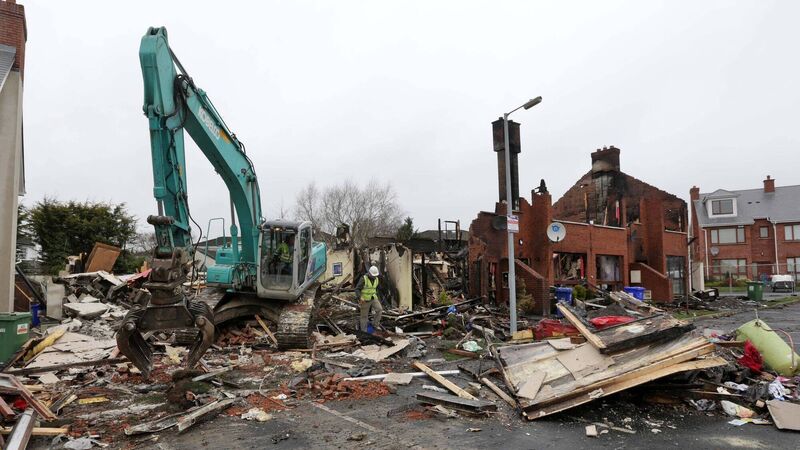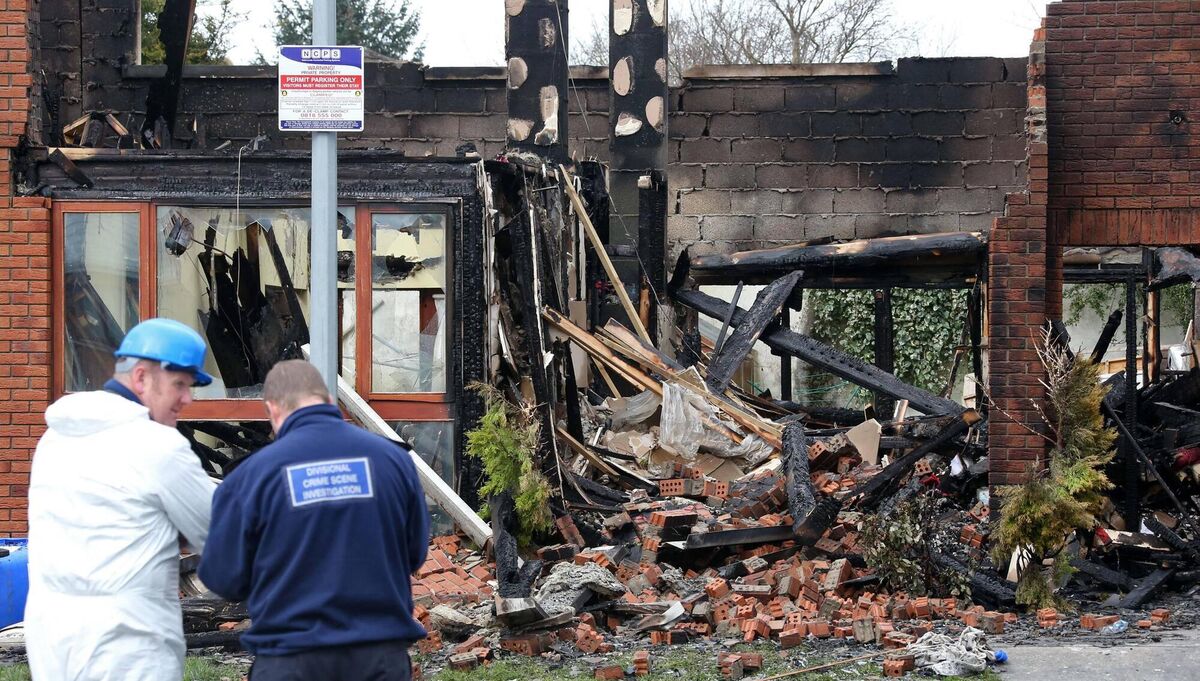Remediation scheme for Celtic Tiger apartments a long time coming

The remains of six terraced houses in Millfield Manor, Newbridge, Co Kildare, which caught fire in April 2015 and burnt to the ground in half an hour. File picture: Colin Keegan
There have been two serious fires due to appalling safety defects in homes built during the Celtic Tiger years. In March 2002, Louise Wall and her partner Mick Farrell died in an apartment in the recently built Verdemont development in west Dublin.
At the time, a garda superintendent compiled a report recommending prosecution against the developer but nothing came of it. There was no follow-up. Recommendations from a coroner were quietly shelved. In the Ireland of the day, there was no stomach for proper accountability of building standards.
In March 2015, a blaze in Newbridge, Co Kildare, burned a terrace of six houses to the ground in just over half an hour. Luckily, there was only one resident in situ in the houses on the Millfield Manor estate on the afternoon it occurred. He got out to safety. If it had happened at night, when over 20 people lived in the homes, there is every possibility that somebody would have died.
“Residents live with that threat every day,” local TD Fiona O’Loughlin (now a senator) told the Dáil two years later. “Not a family photograph survived the fire, not a stick of furniture, and their homes and dreams went up in flames. Every property owner in Millfield Manor is an innocent owner, having bought in good faith and relied on the processes they believe existed in planning and inspection.”
The developer, who, according to Ms O’Loughlin “took shortcuts and made a quick buck”, had gone into receivership by the time the fire occurred.
She was speaking a few months after a fire in Verdemont, 15 years after the fatal blaze, spread quickly and prompted further calls for action.

That action eventually led to an expert report which estimated that between 62,500 and 100,000 apartments or duplexes built between 1991 and 2013 may have defects that require remediation. The most important of these defects was fire safety. On foot of that, and a campaign by the Construction Defects Alliance, representing homeowners, the Government finally gave the go-ahead for a redress scheme that it is estimated could cost €2.5bn.
The nature of these estimates is such that in all likelihood the bill will be higher. The State’s culpability for the defects is down to the fact that the building inspection regime during those heady and illusionary years was practically non-existent. Builders self-certified the work and the State simply let them at it because everybody was busy moving onto the next project, making the next dollar, collecting the next chunk of stamp duty to keep the show on the road.
On Wednesday, Housing Minister Darragh O'Brien brought the details of the remediation scheme to Cabinet for approval. It is expected that legislation to give force to the scheme will be enacted later this year — although that is subject to whether or not a general election is called. For those who have been impacted by the defects, the wheel of justice is turning slowly.
For the people living in houses in Millfield Manor, and other estates, the wheel has come to a stop. The redress scheme is to be designed for apartments and duplexes but not for houses. The logic of this is unclear. For instance, one of the issues that arose in relation to defects was the use of timber-frame construction.
This requires a high degree of precision in installing prefabricated elements of the construction. Without any proper inspection regime, this precision was missing in Millfield Manor and similar estates. The consequences of this are that the building is highly deficient in terms of fire safety. So the timber-frame apartment blocks where defects were uncovered are included in the remediation scheme while similar problems in houses are not.
“It’s only for apartments and duplexes,” said Wayne Proctor, chair of Millfield Manor residents association. “So we’re left out. No state agency whatsoever has come in and said they would assist us. We are being left completely on our own to address these defects that are dangerous.”
It is open to the Government to amend the proposed legislation which would include houses in the scheme. To do so would cost more money but would arguably be more just than leaving houses out of the scheme. Any such amendment could be included during the passage of the bill through the Oireachtas. As things stand the bill is expected to be published in the next six weeks, with pre-legislative scrutiny to follow and the whole process completed by the new year.

Pat Montague of the Construction Defects Alliance noted on Wednesday that the timetable now looks like it will almost definitely be lengthened by the prospect of a general election.
Sinn Féin housing spokesperson Eoin Ó Broin, who was central to the campaign for the establishment of a remediation scheme, says that those who own houses with defects should not be excluded from the scheme. He points out that the expert group which carried out a survey and delivered the report that led to the remediation scheme did not include houses in their survey.
Ó Broin also suggests that the administration of the scheme would be better served if it were handed over to the Pyrite Resolution Board rather than be administered in the form of grant giving by the Housing Agency. “The original pyrite resolution scheme introduced in 2013 was end to end,” he says. “This meant that the resolution board was responsible for the inspections, agreeing on the necessary works with the homeowner, and bringing in and project-managing the building contractor. That scheme has worked well both for homeowners and for ensuring value for money for the taxpayer.”
It is now 13 years since Priory Hall in north Dublin had to be evacuated on foot of a fire safety order due to dangerous defects. At the time, the general spin is that Priory Hall was a result of a rogue builder. Yet three years later, the Irish Examiner exposed shortcomings in Longboat Quay in Dublin’s docklands, which effectively pulled a thread that saw dark secrets and lies spill out from behind the walls of numerous Celtic Tiger developments.
Progress towards restitution and resolution has been painfully slow and even now, as can be seen in the case of house owners, there would still appear to be some foot dragging by the State.













